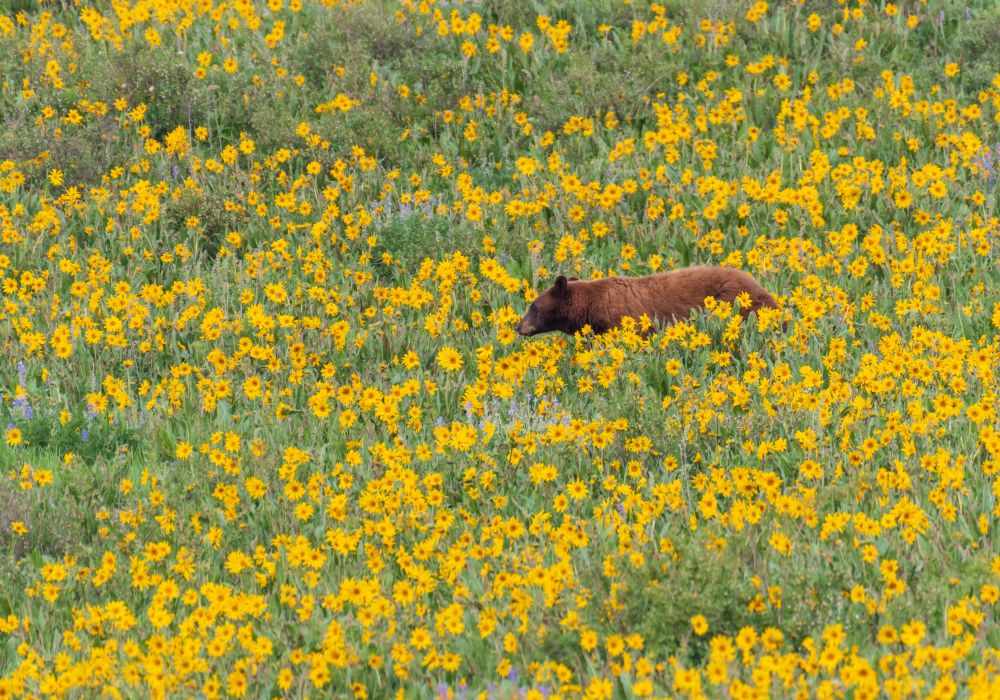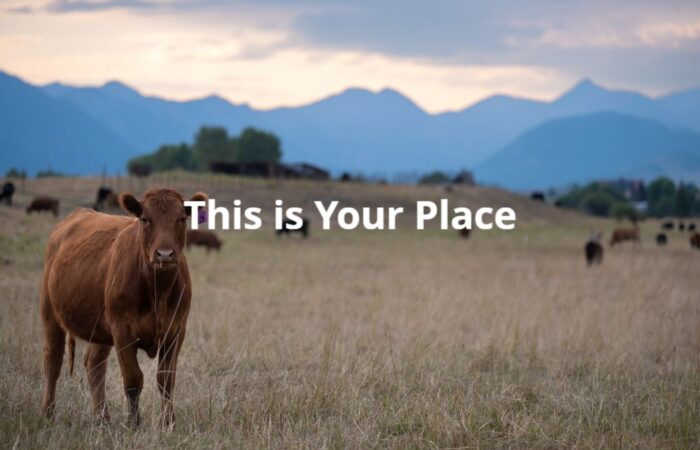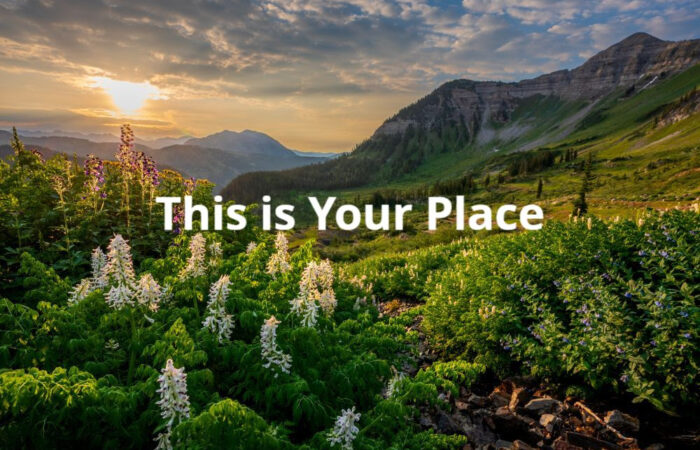2025 Summer Newsletter
Content:
Message from the Executive Director
Preserving the Heart of the High Country
Open Range, Lasting Heritage
Gunsight Bridge Update
Protecting Wildlife Corridors
Supporter Spotlight
Click here for the PDF version.
Message from the Executive Director
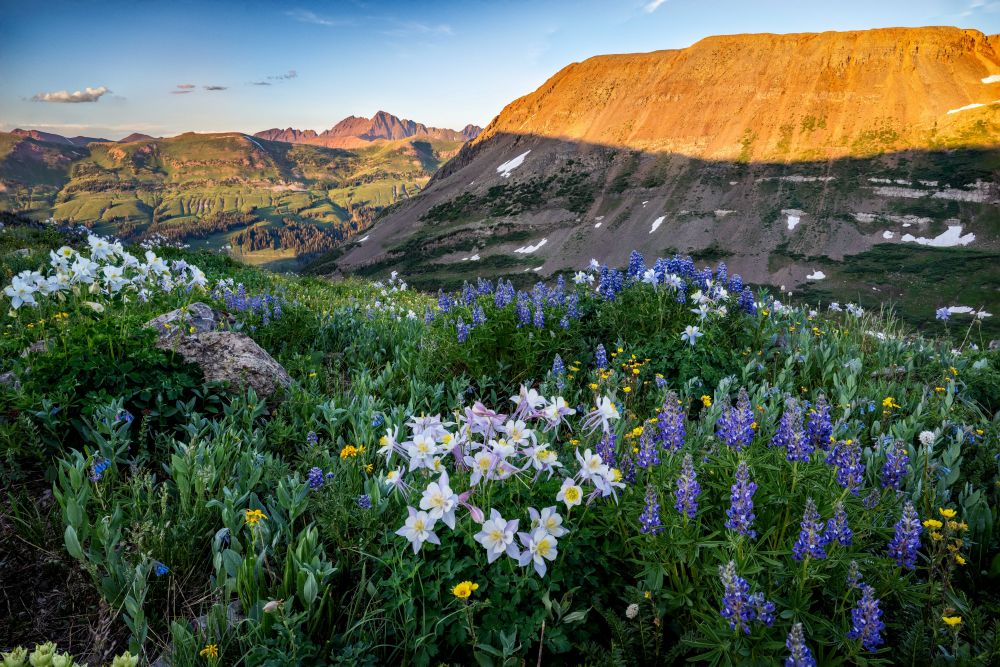
As the rivers, fields, and forest of the Gunnison Valley emerge from their winter slumber, I am proud to share the accomplishments and opportunities made possible through your continued support of the Crested Butte Land Trust. Together, we have protected critical landscapes, strengthened our stewardship efforts, and advanced our mission to preserve the ecological, agricultural, and recreational integrity of the Gunnison Valley.
One of the most significant conservation achievements in our history occurred on August 29, 2024 with the permanent protection of over 885 acres on Mt. Emmons, also known as Red Lady. This historic land exchange and conservation easement ensures the long-term protection of our watershed and beloved landscape. This effort, in collaboration with the Mt. Emmons Mining Company and many other partners, marks a turning point in our collective effort to safeguard the natural beauty, recreation access, and ecological health of the upper valley.
Our Backcountry Conservation Program also saw notable expansion, with the acquisition and protection of several remote patented mining claims in key locations such as the Lake Irwin area, Crystal, and Oh Be Joyful Creek. These small but strategic parcels reduce the risk of habitat fragmentation, maintain public access, and support the long-term connectivity of surrounding wilderness areas.
The protection of wildlife migration corridors remains a priority for our organization. Working closely with landowners and Colorado Parks and Wildlife, we are preserving the seasonal routes used by elk, deer, and other native species as they travel between summer and winter ranges. These corridors, many of which follow ancient trails used by both animals and people for millennia, are essential to the health of our regional ecosystems.
In addition, our commitment to working lands and open range ranching remains steadfast. Nearly all of the lands we’ve conserved support active cattle grazing, providing essential seasonal range and preserving the valley’s agricultural heritage. Open range, combined with conserved land, plays a vital role in sustaining the viability of local ranching operations and maintaining the open landscapes that define the Gunnison Valley.
This year also marked continued stewardship efforts at Gunsight Bridge, where we reinforced infrastructure, monitored habitat restoration, and engaged community stakeholders in shaping the site’s future. This project exemplifies our collaborative approach to land management – where conservation, recreation, ranching, and history intersect to create lasting public value.
We are grateful for the trust you place in us and the shared commitment to preserving the lands that make this valley extraordinary. Every conserved acre, restored habitat, and protected trail reflects the power of community-driven conservation. As we look to the future, we remain focused on protecting the places we love – ensuring they remain wild, working, and welcoming for generations to come.
Preserving the Heart of the High Country
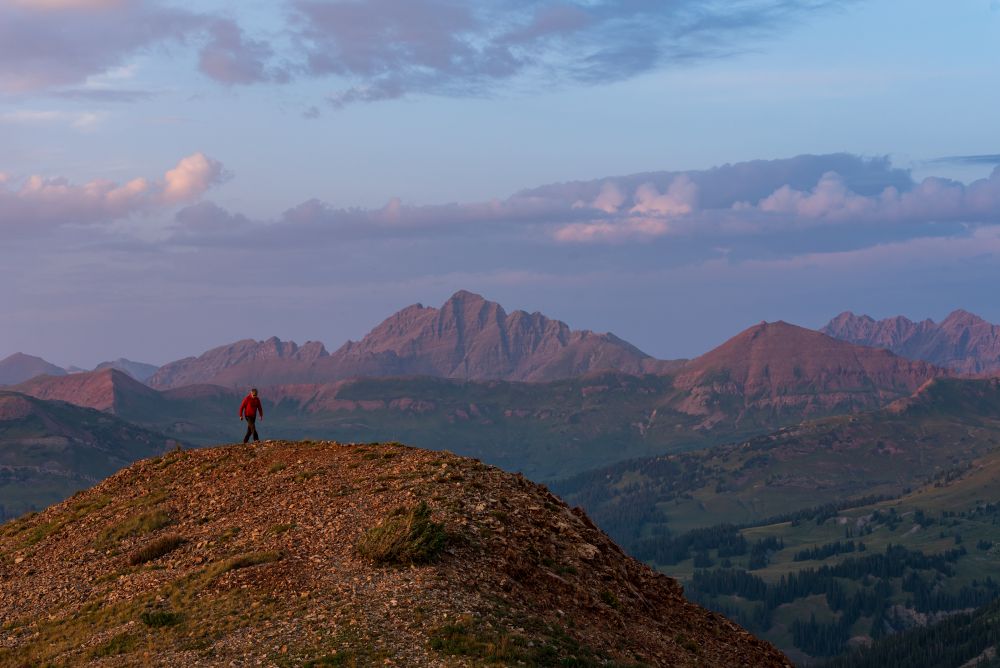
What do the Yankee Blade, Broadax, Silverbow, and Pickwick have in common? Each is a patented mining claim owned by the Crested Butte Land Trust (CBLT) and located within your public lands. These private land parcels are scattered throughout the Colorado backcountry, remnants from the mining days of yore. They are technically inholdings, meaning, what looks like National Forest, may actually be private land. Today these parcels represent conservation opportunities for CBLT. Each small purchase protects broad swaths of land by eliminating the risk of those parcels being developed, access being lost, and habitats becoming fragmented.
If these mining claims could talk, they would tell stories of late 1870s western expansion, the pursuit of fortunes, the silver collapse of the 1890s, and the harsh reality of mineral prospecting in the mountains. While dreams of thick veins of gold and silver never materialized, these private parcels still exist, and CBLT has worked for decades to protect them from development.
CBLT’s Backcountry Conservation Program started in the 1990s with the High Elk Corridor Project protecting hundreds of acres between the Maroon Bells- Snowmass Wilderness and the Raggeds Wilderness Areas. Most recently, and most significantly, CBLT worked with the Mt Emmons Mining Company to conserve Red Lady, 885 acres of patented mining claims and private land, now protected with a conservation easement held by CBLT. From North Pole Basin near Schofield Pass to the Oh Be Joyful valley closer to town, private inholdings embedded within our public lands present opportunities for CBLT to continue protecting the places you love.
The high country has always given generously to those who seek – solitude, inspiration, challenge, and more. While short-term wealth was never realized on these parcels, long-term rewards can be found in their protection. By purchasing these parcels, CBLT is ensuring that future generations will experience the same view that we do today, that wild animals continue to thrive, and that adventure awaits those who seek it out.
It is now our turn to give back. By protecting these lands, we preserve more than just open space – we safeguard the spirit of this valley, its history, and its future. Every acre conserved ensures that the high country remains wild, accessible, and full of possibility for generations to come. Join us in ensuring these lands remain wild and protected for the next generation – because what we save today defines the future of our valley.
Open Range, Lasting Heritage
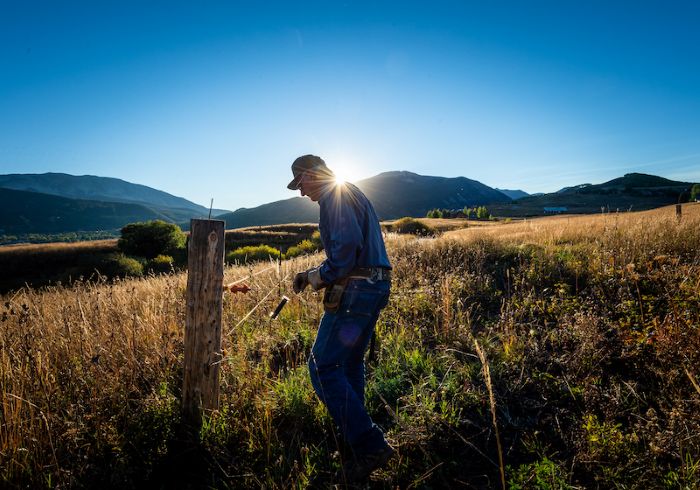
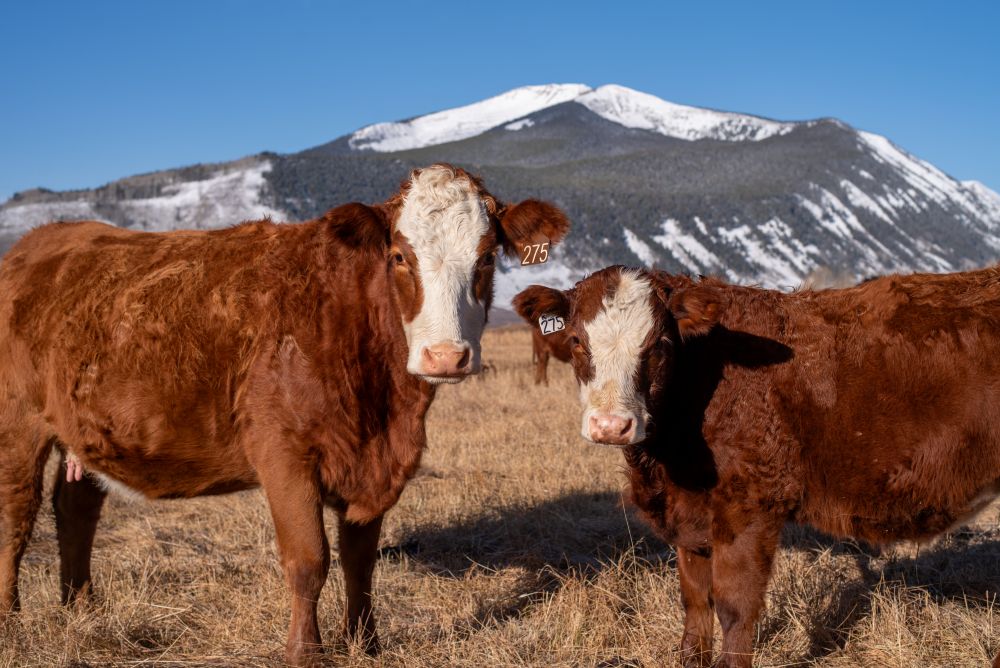
A cowboy, a mountain biker, and a scientist pull up to a trailhead…. Is this the start of a joke, or a regular Tuesday in July? It turns out that conserved lands close to Crested Butte and throughout the Gunnison Valley serve many purposes, including ranching, recreation, and research. To some, the Lower Loop and Lupine trails are amongst the best trails in the nation. To others, the Slate River wetlands are a rare high-altitude ecosystem with endless scientific research potential. And for another group, these lands serve as critical open range for cattle moving between their high country grazing allotments and home ranches in the valley. It would not be unusual on any given day in the summer to encounter cattle and cowboys, world-renowned scientists, and Skittle-colored hikers and bikers on the same trail.
How did this come to be? For starters, Colorado is a “fence out” state, meaning, if property owners don’t want cattle grazing in their neighborhoods, they must maintain fencing to keep cattle out rather than a cattle rancher being required to fence cattle into a particular pasture. Put another way, all land in Colorado is considered open range unless there is a fence to keep cows out.
The second major factor is that ranching has long been an important part of Gunnison County’s economy and culture for many generations, and nearly all the “open space” where we recreate has also been grazed by cattle for over 100 years. Cattle were a part of our landscape long before mountain bikes, ski resorts, and subdivisions. While the notion of open range seems like an artifact of the Old West, it is actually a major factor in how our local landscape is managed today.
What does ranching have to do with the Crested Butte Land Trust? A lot! As a nonprofit that both owns land and holds conservation easements with private landowners, nearly all of the land we’ve protected includes ranching. Much of that land, such as Gunsight Bridge, the Lower Loop, the Lupine trails, and Mt CB Rec Path, helped put Crested Butte on the map as a recreation mecca. These parcels are also important to local ranchers for cattle grazing. While the irrigated pastures throughout the valley are iconic for the preservation of our ranching heritage, the open range supported by conserved lands is essential to the viability of our ranching economy. Without open range, ranching becomes much more difficult, if not impossible, in Gunnison County.
It’s been said that if you like how it looks in the Gunnison Valley, thank a rancher. We couldn’t agree more. From lush green pastures to wildflower meadows and mixed aspen and conifer forests, cattle ranching has shaped the aesthetic of our unique slice of the world. Keeping cattle on the land requires careful consideration of all uses, good fences, good gates, and good communication between groups. The next time you roll up to a trailhead with a mountain bike or floppy sun hat, please give your local cowboy a friendly nod, and please remember to leave the gate as you found it.
Gunsight Bridge Update: The Future of a Historical Parcel
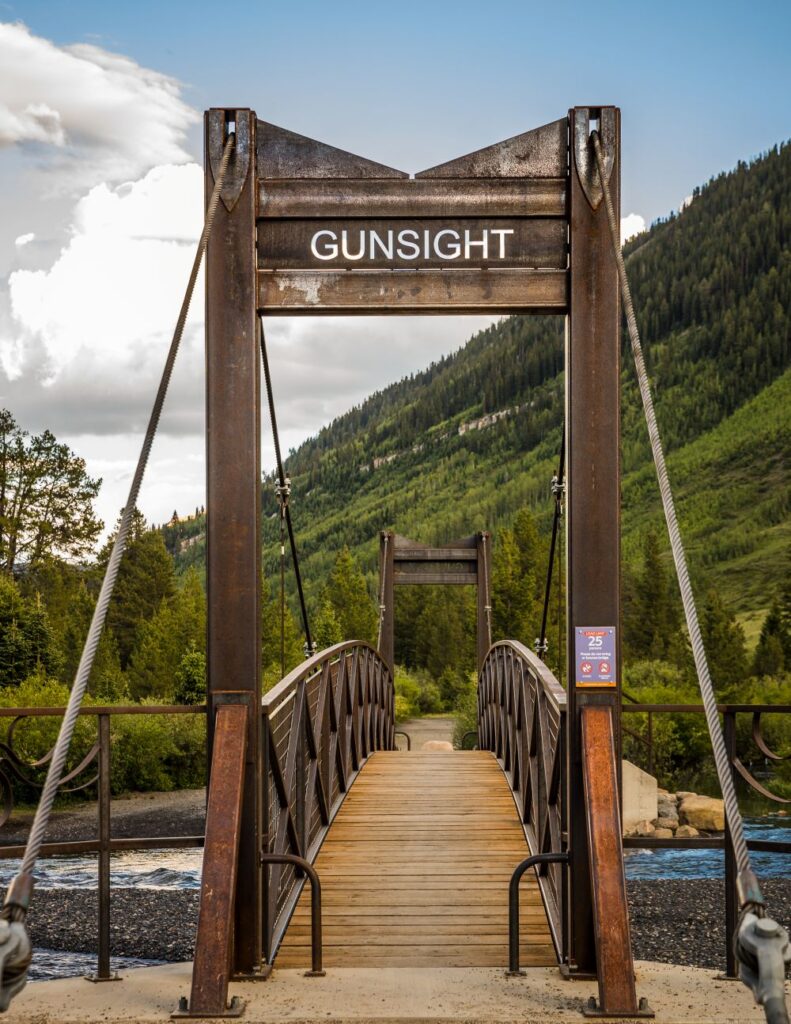
Gunsight Bridge is one of those places where past and present meet, where nature and people intersect. It is more than a landmark, it is a crossroad where the land itself tells a story.
Gunsight Bridge has been a point of passage for over a century. In the late 1800s, the Anthracite Mine bustled with activity just upstream, producing over a million tons of coal. The Denver Rio Grande Railroad’s spur line once crossed the river here, carrying coal and ore out of the valley, its tracks starting just beyond the bridge. As the valley’s economy shifted, the mine faded into history, and the valley embraced a new kind of movement – hikers, bikers, and skiers crossing Gunsight Bridge to explore the wild landscapes beyond.
With all of this traffic, the site needed help by the early 2000s. The bridge was little more than a skeleton, and the surrounding lands bore the scars of mining. Recognizing its ecological and recreational importance, the Crested Butte Land Trust stepped in, purchasing the 120-acre Gunsight Bridge property in 2003 from Pitkin Iron Corporation. The bridge was repaired, with new decking and handrails installed, and the Land Trust embarked on a multi-year effort to heal the land. Working with the Colorado Division of Reclamation, Mining and Safety, acres of wetlands were restored in 2011, with 15,000 wetland plants carefully reintroduced to stabilize the riverbanks.
But the work wasn’t done.
In studying the health of the Slate River, it became clear that the bridge itself had become part of the problem, disrupting the river’s natural flow and contributing to erosion along a quarter-mile stretch of the corridor. To truly restore this place, a new bridge was needed. In 2019, the Land Trust completed a 100-foot suspension bridge designed to better withstand the dynamic nature of the Slate River while positively impacting the river, its floodplain, and the surrounding habitat.
Today, the Land Trust’s commitment to Gunsight Bridge remains unwavering. Last year, we armored the bridge abutments from erosion, ensuring its long-term integrity. This summer, we will reconvene a diverse range of stakeholders, including recreationists, conservationists, local government, and community members, to collaboratively address the ongoing needs of the Gunsight Bridge area.
Gunsight Bridge is a reminder of our past, a gateway to adventure, and a testament to what happens when people come together to protect the lands they love. With your support, we can continue to care for this iconic place, ensuring that future generations will stand at this crossroads and see the same clear waters, open landscapes, and wild beauty that we cherish today.
Ancient Pathways: Protecting Wildlife Corridors
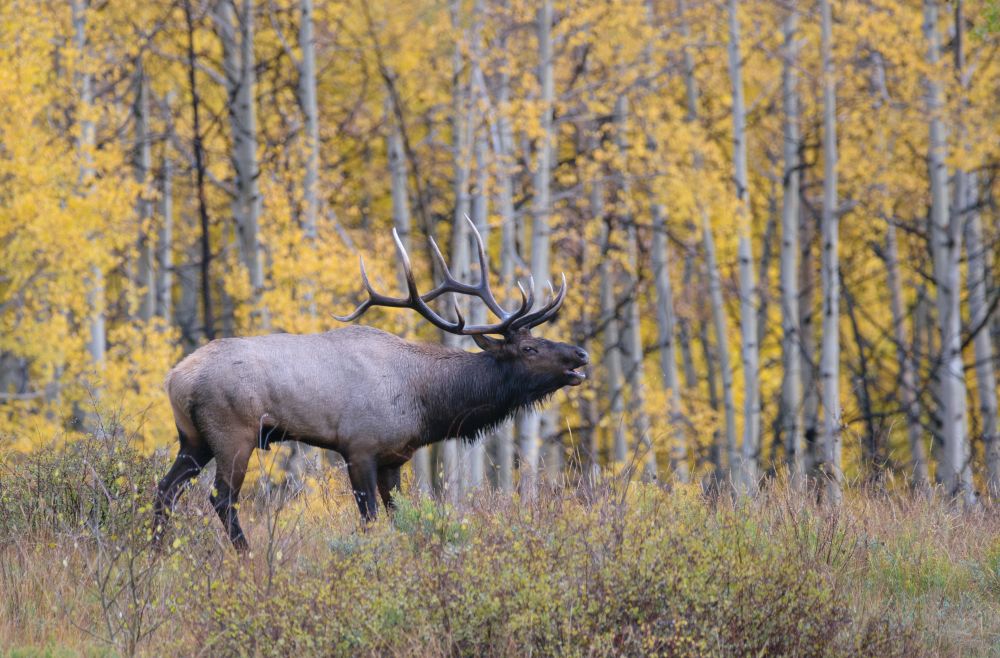
The Gunnison Valley is famous for its trails. Indigenous hunting trails became mining routes which became depression-era Civilian Conservation Corps trails that now form our backcountry trail network. Hunters and cowboys rely on those trails and other routes to harvest game and manage livestock. Mountain bikers and hikers love the same trails for the access they provide to conserved and public lands. While humans have been moving through these mountains for millennia, the routes they followed were most certainly created by many of the same large mammals that can be found here today. For the elk, bighorn sheep, and deer that migrate annually through these mountains, the trails they walk have likely been used by animals and people since the glaciers retreated from the southern Rockies 13,000 years ago.
With this historic context, the current migration of large animals across the landscape is a stunning display of an ancient ritual. These animals are constantly on the move, and conserved land in the Gunnison Valley provides critical habitats for their survival. Today, we know through Colorado Parks and Wildlife’s radio collar tracking program that local elk travel up to 70 miles twice a year between their summer and winter ranges. This is the area between Saguache in the San Luis Valley and Marble in the far northern portion of Gunnison County. Within that range are critical habitats that provide winter forage, spring calving ground, and summer grazing.
The routes they travel include private and public lands that possess some similar attributes including few people, good forage, water, and cover from predators. You will see elk cows and calves playing in wetland ponds and marshes along the Slate River, bulls bugling during the fall rut, and larger herds moving across open hillsides if you know where and when to look.
Ensuring that our local elk herds can continue to thrive in the Gunnison Valley involves careful consideration of where land should be developed and where it should be conserved. When CBLT explores conservation opportunities with private landowners, wildlife habitats are always considered and protected. Sometimes those habitats can coexist near development and sometimes those habitats need a large buffer from development to keep the animals on the land. CBLT is proud to protect thousands of acres critical to the survival of wildlife in the Gunnison Valley including our cherished big game species, bears, beavers, and birds like the Great Blue Heron.
If you ever marveled at seeing a moose along the Slate River, elk cows and calves frolicking in the marsh, or a giant heron hunting fish along the stream bank, you are witnessing the benefits of private land conservation in the Gunnison Valley. The broad swaths of public land in Gunnison County are the reason we have abundant and healthy wildlife populations. The private conserved land near where we live is the reason we can see and enjoy these animals close to home.
Supporter Spotlight: Karen and Xavi Fane
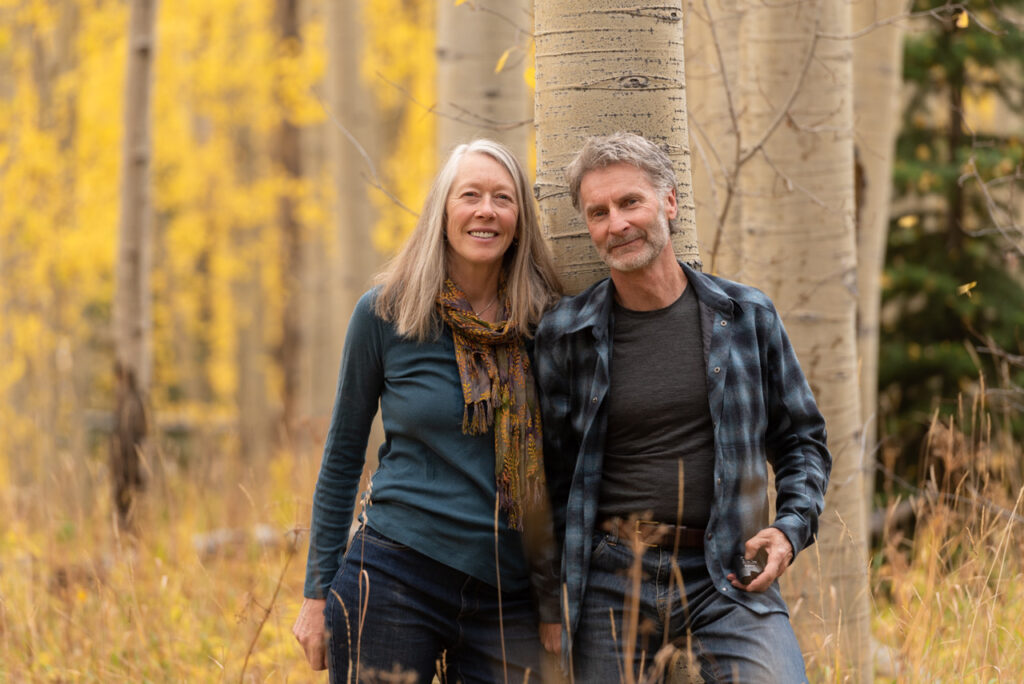
Karen Janssen and Xavi (pronounced “Chevy”) Fane have spent decades giving back to Crested Butte through art, education, and support of their environment and conservation. As longtime community members, their dedication to the land and its people has left a lasting impact.
Karen and Xavi met in Crested Butte after both discovering the valley in the 1980s. They arrived as winter seasonal workers and immediately fell in love with the small, tight-knit community and the open lands that surrounded them. Though they found Crested Butte at different times, they both moved here in October, a coincidence they still celebrate every year.
“We both just love the natural world and the quiet it provides,’’ says Karen. “We have a deep sense of place and embrace each season as it comes.”
Karen, an educator and founder of KJ’s Music Academy (offering music education for kids of all ages), has been involved with the Land Trust since its early days. She served on the Board of Directors from 2009 to 2016 and continues to advocate for local conservation as a longtime board member of 1% for Open Space. Her work is driven by a commitment to both education and conservation, ensuring that future generations understand the importance of protecting open spaces. “For me, it’s about the kids,” she says. “So much of this work is for the next generation.”
Xavi, an avid outdoorsman and photographer, has spent decades capturing the magic of the Gunnison Valley. Whether gliding along the local Crested Butte Nordic trails or hiking deep into the backcountry, his lens brings
to life the landscapes that define Crested Butte. His images do more than document the land – they connect people to it. By sharing his photography with local nonprofits, he helps unify organizations and the community, highlighting the shared love for open spaces and outdoor recreation. “I am a nature-loving guy, and my photography is an extension of that,” he says. “I am able to give back to the community through my skills, which is photography.”
Together, Karen and Xavi remind us that conservation isn’t only about protecting land – it’s about building a community that cherishes it. Whether through advocacy, education, or art, their work ensures that the story of this valley continues to be one of shared passion and preservation for generations to come.
Your Support Matters to the Gunnison Valley. See Crested Butte Land Trust’s Impact for 2024 in Numbers
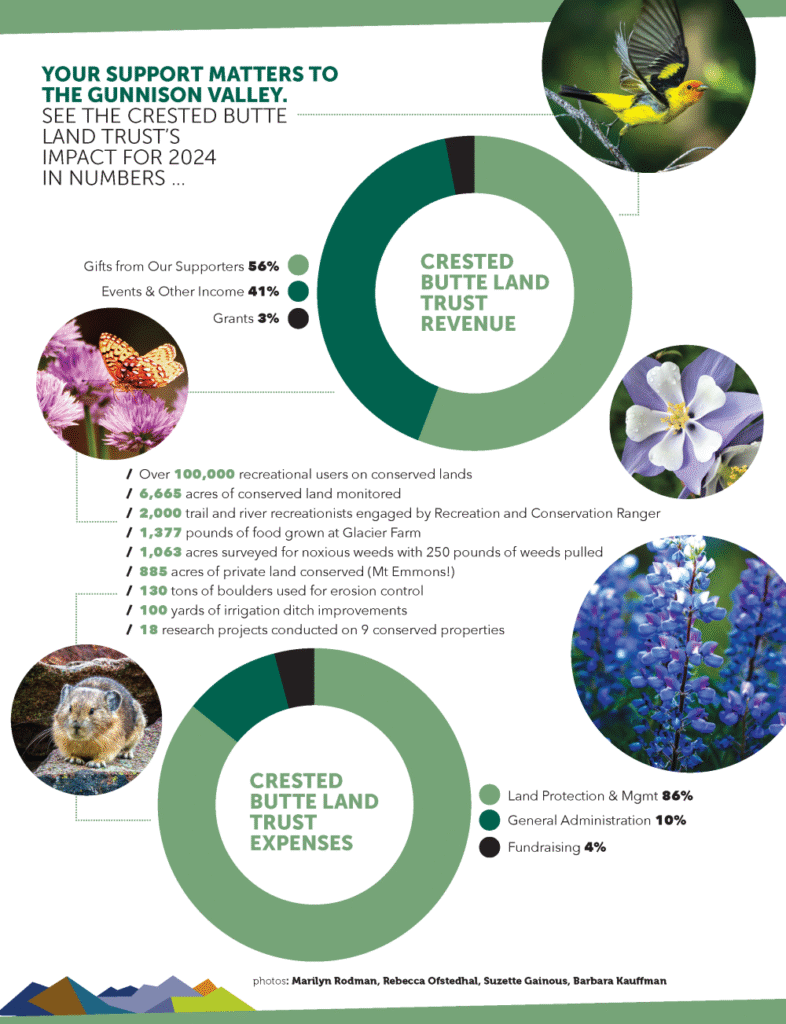
- Over 100,000 recreational users on conserved lands
- 6,665 acres of conserved land monitored
- 2,000 trail and river recreationists engaged by Recreation and Conservation Ranger 1,377 pounds of food grown at Glacier Farm
- 1,063 acres surveyed for noxious weeds with 250 pounds of weeds pulled
- 885 acres of private land conserved (Mt Emmons!)
- 130 tons of boulders used for erosion control
- 100 yards of irrigation ditch improvements
- 18 research projects conducted on 9 conserved properties
Crested Butte Land Trust Revenue:
Gifts from Our Supporters – 56%
Events and Other Income – 4%
Grants – 3%
Crested Butte Land Trust Expenses:
Land Protection and Management – 86%
General Administration – 10%
Fundraising – 4%
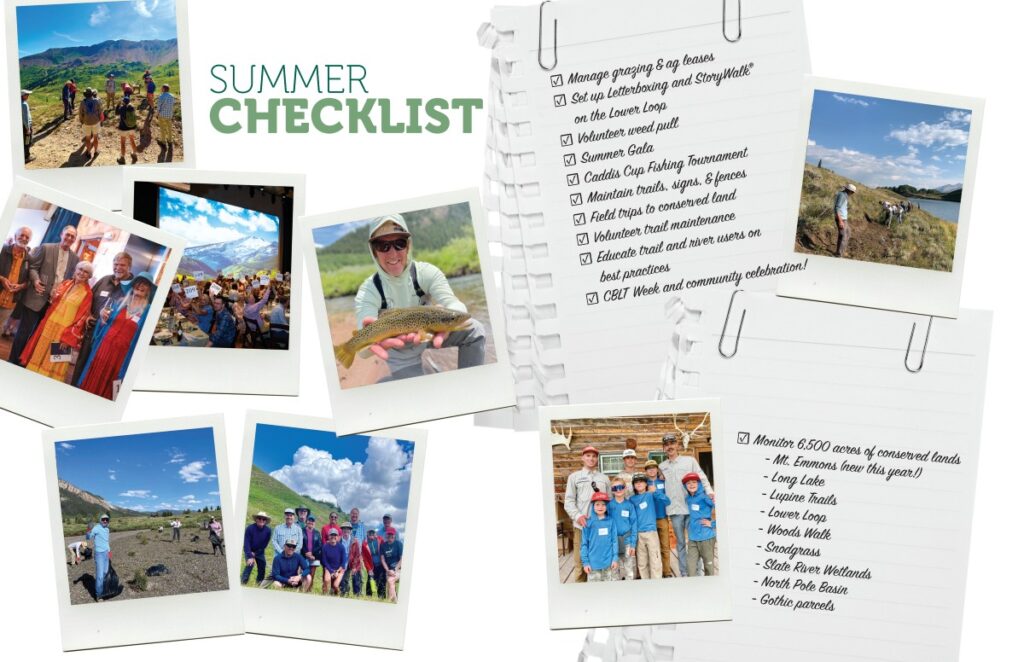
Summer Checklist
- Manage Grazing & ag leases
- Set up Letterboxing and StoryWalk® on Lower Loop
- Volunteer weed pull
- Summer Gala
- Caddis Cup Fishing Tournament
- Maintain trails, signs, and fences
- Field trips to conserved land
- Volunteer trail maintenance
- Educate trail and river users on best practices
- CBLT Week and community celebration
Monitor 6,500 acres of conserved lands
- Mt Emmons (new this year)
- Long Lake
- Lupine Trails
- Lower Loop
- Woods Walk
- Snodgrass
- Slate River Wetlands
- North Pole Basin
- Gothic parcels
Crested Butte Land Trust Board of Directors
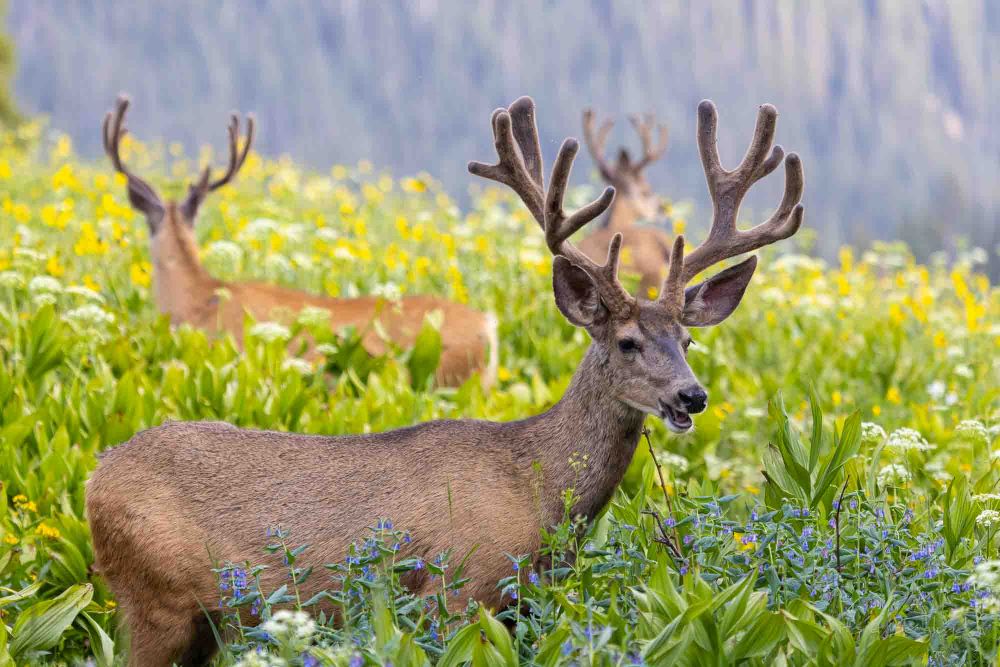
Kelly Harrison, Board President
Mike Higuera, Vice President
Jill Indovino, Treasurer
Kiley Flint, Secretary
Zach Chenault
Win Craven
Peter Dea
Jamie Henkel
John Mahoney
Lee Rigby
Chris Riopelle
John Simmons
Terri Von Dohlen
“I enjoy volunteering for the Land Trust because of all the great people involved in the organization. Being able to help protect land in a spot as beautiful as Crested Butte is an honor and a privilege. I love how land trusts work with willing landowners to protect properties with attributes like beautiful views and wildlife habitats.”
– Mike Higuera, Vice President
Get Involved!
Donate or Volunteer
Invest in your community! There are lots of ways you can support your local land trust.
Leave a Legacy
Please consider the Crested Butte Land Trust in your will or retirement plan.
Events
We hope to see you soon at one of our field trips, the Starry Evening Gala, the Caddis Cup Fly Fishing Tournament, and more! Visit cblandtrust.org or contact Development Director Ashley UpChurch at ashley@cblandrust.org or 970-349-1206 to learn more.
